

The Royal House of LaBeija has never been about fitting in—it’s about standing out, standing up, and standing firm. It’s about that undeniable presence, that unshakable truth, that audacity to exist in full, radiant color. And let’s be real—without LaBeija, the culture just wouldn’t be the culture.
As part of the Crystal Clear Campaign, honoring the legendary Crystal LaBeija, we present the LaBeija Spotlight Series—a tribute to those who built the foundation, those carrying the torch today, and those shaping what’s next. This isn’t about nostalgia; it’s about legacy. It’s about making sure the blueprint is acknowledged, the architects are celebrated, and the future is documented on our terms, not as a footnote in someone else’s version of history.
Too often, the brilliance of LaBeija is overlooked, even in spaces we architected. That ends here. The LaBeija Spotlight Series is a living, breathing archive of those who have defined, redefined, and will continue to define this house and this culture. It’s not just about recognition—it’s about visibility, truth, and taking up the space we created.
This blog post will evolve, just like the House of LaBeija. With each new highlight, we’re adding to a legacy that refuses to be dimmed. Because the impact of Crystal LaBeija is eternal, and the vision she set forth will always be crystal clear.

Member Spotlight: Seth Falk aka Panther LaBeija
Seth Falk aka Panther LaBeija is making history as one of the first Black zoo owners in North America, combining his deep love for animals with a passion for innovation. His entrepreneurial spirit shines through his work, where he brings both creativity and compassion to everything he touches. Not just a visionary in the animal world, Seth is also a force in the world of fashion, constantly pushing boundaries with his unique style. A member of the Royal House of LaBeija, he walks the runway and aspires to compete in Sex Siren, showcasing his commitment to the art of expression.
But Seth’s impact extends far beyond business and fashion. His dedication to giving back is evident in his volunteer work with foster care children and seniors in nursing homes. He’s a true connector, having built a second family out of his NYC chapter and now being deeply involved with the Cape Town chapter, strengthening global bonds. Seth’s superpower is his ability to find strength in adversity, always letting love and laughter lead the way. Whether in the zoo, on the runway, or in his community work, Seth embodies resilience and the power of connection.

HISTORY SPOTLIGHT: CRYSTAL LABEIJA
Ballroom Pioneer and Founder of The Royal House of LaBeija
Crystal LaBeija, a trailblazer in New York City's ballroom scene, is credited as the founding mother of the House of LaBeija, established in 1968. Her influence extends far beyond the house, as she was a key figure in creating the modern ballroom culture that celebrates the artistry and identity of LGBTQ+ Black and Brown communities. Prior to founding the House of LaBeija, Crystal was a highly respected drag performer, known for her beauty, charisma, and outspokenness. Her public critique of racial bias in the drag pageant circuit, famously highlighted in the 1967 Miss All-America Camp Beauty Contest, became a pivotal moment in LGBTQ+ history.
Crystal's decision to create the House of LaBeija marked a revolutionary act of resistance. By providing a space where marginalized individuals could freely express themselves and celebrate their identities, Crystal laid the groundwork for the ballroom house system that continues to thrive today. As the first house mother, she not only led her house but also inspired the creation of numerous other houses, shaping a legacy that endures. Crystal's contributions to ballroom culture remain a beacon of empowerment and artistry, cementing her place as one of the most influential figures in LGBTQ+ history.
For a visual tribute to Crystal LaBeija's impact, you can explore her iconic moments in the documentary The Queen(1968), where her boldness and grace are captured for future generations.

Member Spotlight: Mary Jane LaBeija
Maria Clara, known as Mary Jane on the ballroom floor, proudly represents the Iconic House of LaBeija with a vibrant touch of Brazil. As the Mother of the house’s upcoming Brazilian chapter, she is dedicated to upholding and expanding its storied legacy. Maria’s ballroom journey began in 2018 with TRAGA (@traga_brasil), an initiative that explored ballroom culture through classes, balls, and collaborations with local trailblazers in Sorocaba. Her early work laid the foundation for a thriving community and deepened her commitment to ballroom’s traditions and values.
Since joining the House of LaBeija in 2021, Maria has drawn inspiration from its rich history, honoring the legacy of Mothers Crystal, Lottie, and Pepper. In a country where life remains perilous for the transgender community, Maria is committed to creating a sanctuary where her children can dream and thrive in safety. Through her leadership, she continues to foster a space of empowerment and resilience, ensuring that the legacy of the Iconic House of LaBeija resonates deeply in Brazil and beyond.

HISTORY SPOTLIGHT: MARLOW LABEIJA
Meet Marlow (He/Him/They)
Marlow is a living legend within the Royal House of LaBeija. At 83 years old, Marlow began his ballroom career alongside Crystal LaBeija herself, standing as one of the early pillars of the house’s legacy. He was part of the house during its formative years in the late 1960s and early 1970s, when ballroom was still underground and deeply shaped by the resilience and creativity of Black and Latinx queer communities. Marlow walked in the earliest LaBeija balls and was known for his striking Face and runway presence. He won multiple Grand Prizes for Face and was one of the first LaBeijas to dominate the category of All-American Runway with his signature walk and effortless style.
Marlow’s influence extended beyond the ballroom floor. He helped Crystal organize some of the earliest LaBeija balls, ensuring that the events were not only showcases of beauty and talent but also acts of defiance and community building. Marlow was known for mentoring younger house members, often helping them perfect their runway walks and Face presentation. His artistic vision played a major role in shaping the house's signature aesthetic—elevating opulence, grace, and precision. A fun fact? Marlow’s legendary Face walk in the 1973 LaBeija Ball is still talked about today—it was so flawless that Crystal herself crowned him the night’s standout performer.
Marlow’s journey into the Royal House of LaBeija was inspired by Crystal LaBeija’s strength and vision. He was drawn to the sense of family and the deep history of resilience and artistry that LaBeija represented. A standout moment for Marlow was winning his first Grand Prize in Face—it was a full-circle moment that affirmed his place in ballroom. Today, Marlow continues to live his life as a woman but prefers his biological pronouns. His legacy remains an inspiration to the next generation of ballroom talent, with his dream of merging ballroom opulence with streetwear edge living on through the community he uplifted.
➡️ Visit Marlow’s work and portfolio: marlowlafantastique.weebly.com

Member Spotlight: Queen Mother Vivian LaBeija
Queen Mother Vivian LaBeija’s story is one of transformation, resilience, and a mission to empower others. Originally from Philadelphia, Vivian discovered the ballroom scene in 1995 as a teenager. Watching a transgender woman command the Latex Ball wasn’t just inspiring—it was revolutionary. It unveiled a truth she had always known but hadn’t yet dared to claim: that her internal identity could align with her outward existence. At 19, Vivian began her physical transition, navigating the challenges of embodying her authentic self as a 6'5" Black trans woman. After the tragic loss of her husband to a violent home invasion, she moved to New York to rebuild her life. It was here, within the embrace of the Royal House of LaBeija, that she found community, purpose, and the courage to lead.
In 2019, Vivian debuted as Mother LaBeija, stepping into a role that would allow her to lead with both grace and determination. Her mission became clear: to create space for Black trans women to lead, to be seen, and to thrive unapologetically. By 2022, her influence extended far beyond ballroom when she was featured in The House of LaBeija, a narrative short film that premiered at the Tribeca Film Festival. The film celebrated the house’s rich legacy, with Vivian as a living testament to its enduring power. Her presence in the film wasn’t just about representation—it was a declaration that women like her have stories worth telling and lives worth honoring.
In addition to her role as Queen Mother, Vivian is a working mother, a title she wears with pride and determination. For a transgender woman of her stature, balancing the demands of motherhood, leadership, and career is no small feat. Since 2023, she has worked successfully as a makeup consultant with Ulta Beauty, using her artistry and expertise to help others express their beauty authentically. Her ability to navigate professional spaces with poise and confidence serves as an inspiration to all women, especially those striving to break barriers and redefine what success looks like.
In April 2023, Vivian continued her mission by spearheading the Royal House of LaBeija’s collaboration with Sephora for the “We Belong to Something Beautiful” campaign. This groundbreaking initiative celebrated Black and queer artistry, shining a light on the resilience and brilliance of ballroom culture. For Vivian, this was more than a campaign—it was an opportunity to redefine beauty standards and demand a place at the table for women like her.
Queen Mother Vivian LaBeija’s leadership is rooted in a deep sense of purpose. Her mission is to inspire the next generation of Black trans women to take up space, live boldly, and lead authentically. She reminds us all that true power comes from being unapologetically yourself and lifting others as you rise.

HISTORY SPOTLIGHT: MOLDAYVIA LABEIJA
Moldavia LaBeija was a prominent figure in New York City's ballroom scene during the late 1980s and early 1990s. As a member of the House of LaBeija, she was celebrated for her elegance and poise, particularly excelling in categories like Femme Queen Realness. Her performances set a standard within the ballroom community, inspiring many who followed.
While specific details about Moldavia's tenure and titles within the House of LaBeija are not extensively documented, her influence is evident. She is featured in Chantal Regnault's 1991 photograph titled "Legendary Moldavia LaBeija," which captures her returning from a ball, highlighting her status within the community. https://artsandculture.google.com/asset/legendary-moldavia-labeija-chantal-regnault/AgGPJiZKwIjAtA
Additionally, her participation in events like the 1992 Montana Ball at the Marc Ballroom in New York City underscores her active role in the scene.
For a visual representation of Moldavia LaBeija's impact, you can view the following video:

HISTORY SPOTLIGHT: PEPPER LABEIJA
Pepper LaBeija was more than a ballroom icon—she was a cultural force who reshaped the landscape of New York City's drag and ballroom scene. Born William Jackson on November 5, 1948, in the Bronx, Pepper ascended to the helm of the House of LaBeija in 1972, following the legendary Crystal LaBeija. What followed was nothing short of historic.
With a keen eye for fashion and an unmatched sense of grandeur, Pepper led the House of LaBeija through its golden era, solidifying it as a cornerstone of ballroom culture. Her leadership was fierce, graceful, and visionary. Under her reign, the house wasn’t just winning—it was defining what winning looked like.
Pepper’s extravagant gowns, sharp wit, and undeniable presence earned her over 250 trophies in drag ball pageants. But trophies were only a fraction of her legacy. She was featured in the seminal 1990 documentary Paris Is Burning, where her commanding storytelling and charismatic energy introduced the world to the magic and resilience of ballroom life. She didn’t just walk the runway—she walked into history.
Despite immense challenges—including severe health complications that led to the amputation of both feet—Pepper remained devoted to her community until her passing on May 14, 2003. Her spirit, however, continues to reign.
Pepper LaBeija’s name lives on not only through her house, but through every performer who dares to be fabulous, every queen who leads with power and poise, and every moment of joy sparked on a ballroom floor. She is forever a part of our collective heartbeat—a brilliant, unshakeable matriarch of style, soul, and survival.
In this Crystal Clear spotlight, we honor Pepper LaBeija as an eternal symbol of resilience, leadership, and cultural legacy.

Member Spotlight: Lucy LaBeija
Peter (he/him), known as Lucy in the ballroom scene, is a member of the Eastern European chapter of the Royal & Iconic House of LaBeija, based in Warsaw, Poland. He walked his first ball in 2019 and became a full member of the community in 2021, discovering a deep love for Old Way, his main category. Peter admires Old Way for its combination of diverse dance styles, captivating music, and the freedom to create a unique performance. Drawing on his four years of capoeira training, he infuses his movements with precision and flair. Outside of Old Way, Peter has been performing drag for seven years as Lucy d'Arc, adding another layer of artistry to his ballroom persona.
Joining the House of LaBeija was a way for Peter to embrace the house’s rich legacy and contribute to its impact on ballroom and queer history. Being part of LaBeija has inspired him to carry the name with pride, strive for excellence, and push beyond his limits, such as preparing to walk the Latex Ball in 2024. Looking ahead, Peter aspires to become a guide and mentor, offering the support and friendship his younger self longed for, blending his roles as a teacher and an ally to the next generation of ballroom talent.

Member Spotlight: Junior LaBeija
Junior LaBeija is a distinguished figure in New York City's ballroom scene, renowned for his role as an emcee and his significant contributions to the culture. While specific details about his joining date and tenure within the House of LaBeija are not extensively documented, his impact is widely recognized. Junior gained prominence through his dynamic emceeing style, notably featured in the 1990 documentary Paris Is Burning, where his charismatic commentary and catchphrases, such as "Opulence! You own everything!", became iconic within the LGBTQ+ community.
Beyond his role in the ballroom, Junior LaBeija has been an active advocate for LGBTQ+ rights and a historian of ballroom culture. He has participated in panels and discussions, sharing insights into the struggles and triumphs of queer people of color. His eloquence and depth of knowledge have made him a respected voice in preserving and promoting the history and significance of ballroom culture. Junior's enduring presence continues to inspire new generations within the community.

Member Spotlight: Divine Prince Gulf Coast Godfather
The Divine Prince Ty Emmecca (He/She/They/Them) is the Gulf Coast Father and godparent of the Royal Iconic House of LaBeija. Based in New Orleans, Louisiana, the Divine Prince is a professional actor (SAG) and cultural performer whose career spans television, film, and documentaries showcasing New Orleans culture. As a Black masking Mardi Gras Indian, his intricate hand-beaded creations have been internationally recognized, including a feature in Les Black Indians de la Nouvelle-Orléans at the Musée du Quai Branly–Jacques Chirac in Paris, France. He is also known as the King and Leader of authentic New Orleans Voodoo, a role deeply rooted in his heritage.
The Divine Prince’s introduction to Ballroom came in the early 1980s as a teen runaway in NYC. Invited into the House of LaBeija as a leader and godparent, Ballroom became a place of healing and renewal for him. One of his proudest moments was walking Bizarre at the Latex Ball, where the community’s love and support left a lasting impression. Today, he continues to share his creativity and strives to bring other talented individuals into media and film, both inside and outside of Ballroom.

History Spotlight on Candy LaBeija
Candy LaBeija was a prominent figure in New York City's ballroom scene, particularly during the 1970s and 1980s. As a member of the House of LaBeija, she contributed to the house's reputation for excellence in performance and style. While specific details about her tenure and titles within the house are not extensively documented, her influence within the community is acknowledged by those familiar with the era.
The House of LaBeija, established in 1968 by Crystal and Lottie LaBeija, is recognized as the first ballroom house, providing a supportive environment for LGBTQ+ individuals, especially people of color. Candy's participation in them house contributed to its enduring legacy of fostering self-expression and community support.
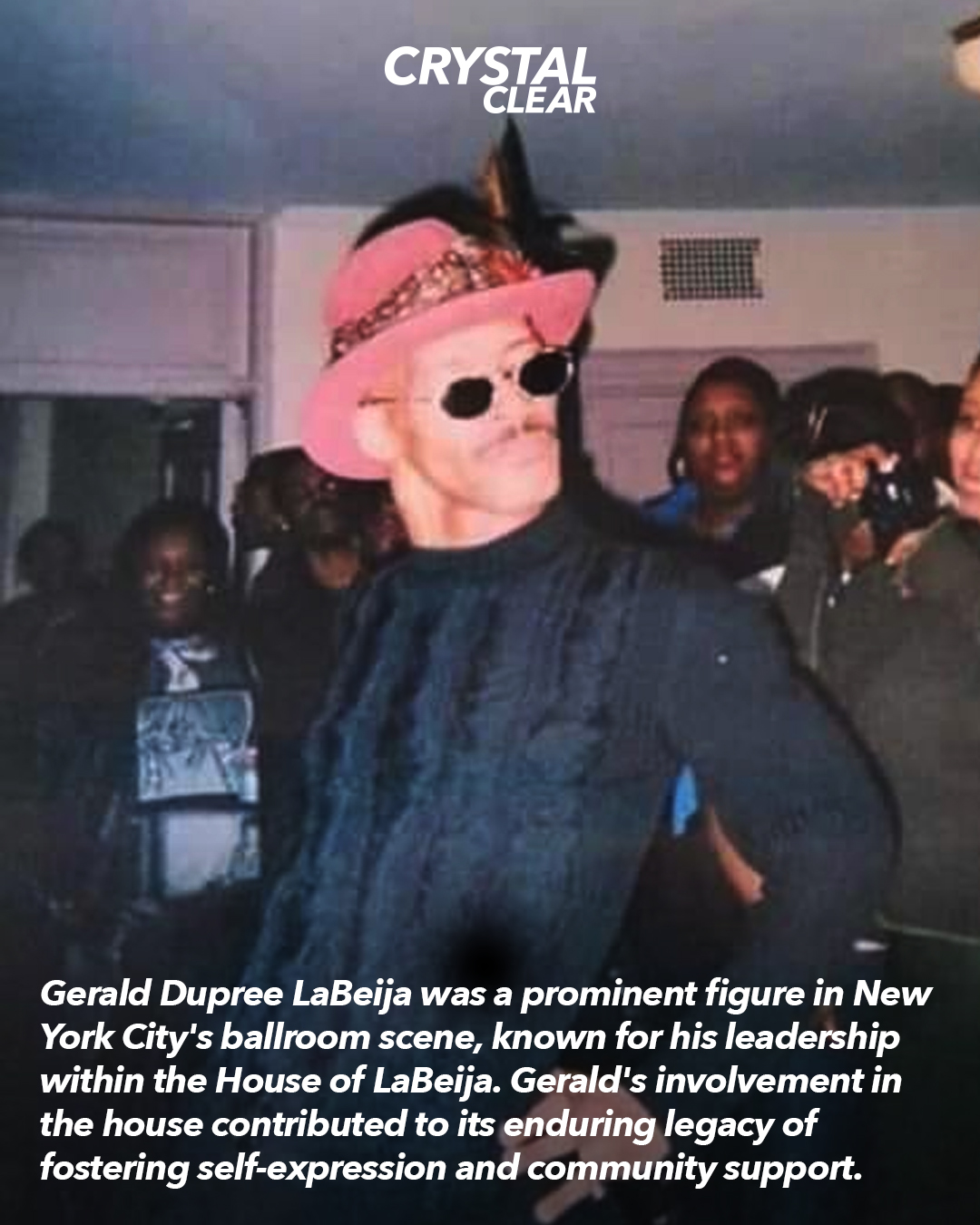
History Spotlight : Gerald LaBeija
Gerald Dupree LaBeija was a prominent figure in New York City's ballroom scene, known for his leadership within the House of LaBeija. While specific details about his tenure and titles within the house are scarce, his influence and contributions to the ballroom community are well recognized. The House of LaBeija, established in 1968 by Crystal and Lottie LaBeija, is celebrated as the first ballroom house, providing a supportive environment for LGBTQ+ individuals, particularly people of color. Gerald's involvement in the house contributed to its enduring legacy of fostering self-expression and community support.
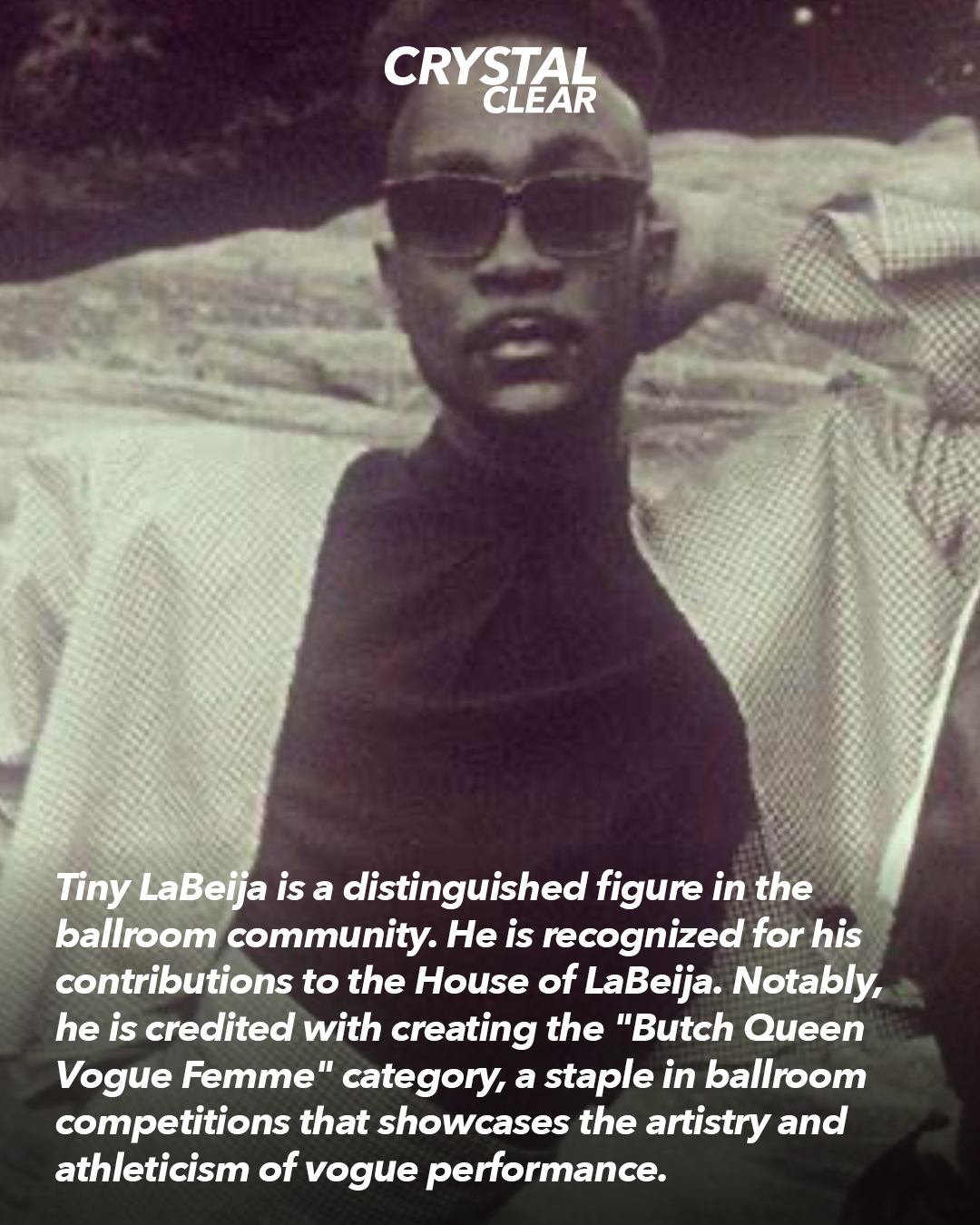
History Spotlight : Tiny LaBeija
Tiny LaBeija is a distinguished figure in the ballroom community, recognized for his contributions to the House of LaBeija. As a prominent member, Tiny has upheld the house's legacy of excellence in performance and leadership. His participation in various balls, such as the Dorian Corey Awards Ball in 2013, showcases his enduring influence and commitment to the culture.
The House of LaBeija, established in 1968 by Crystal LaBeija and Lottie LaBeija, is credited with initiating the house system within ball culture. This system has provided a familial structure and a platform for self-expression for LGBTQ+ individuals, particularly those from marginalized communities. Tiny LaBeija's ongoing involvement exemplifies the house's mission to inspire self-expression and achieve personal and professional excellence through ballroom culture. Royal House of Labeija
For a visual representation of Tiny LaBeija's impact, you can view his performance at the Dorian Corey Awards Ball in 2013:
Tiny LaBeija is a distinguished figure in the ballroom community, recognized for his contributions to the House of LaBeija. Notably, he is credited with creating the "Butch Queen Vogue Femme" category, a staple in ballroom competitions that showcases the artistry and athleticism of vogue performance.
While specific details about Tiny LaBeija's tenure in the House of LaBeija, including the exact dates of his membership and any formal titles he may have held, are not readily available, his impact on the ballroom scene is evident through his innovative contributions and enduring influence.
For a visual representation of Tiny LaBeija's impact, you can view his performance at the Dorian Corey Awards Ball in 2013:
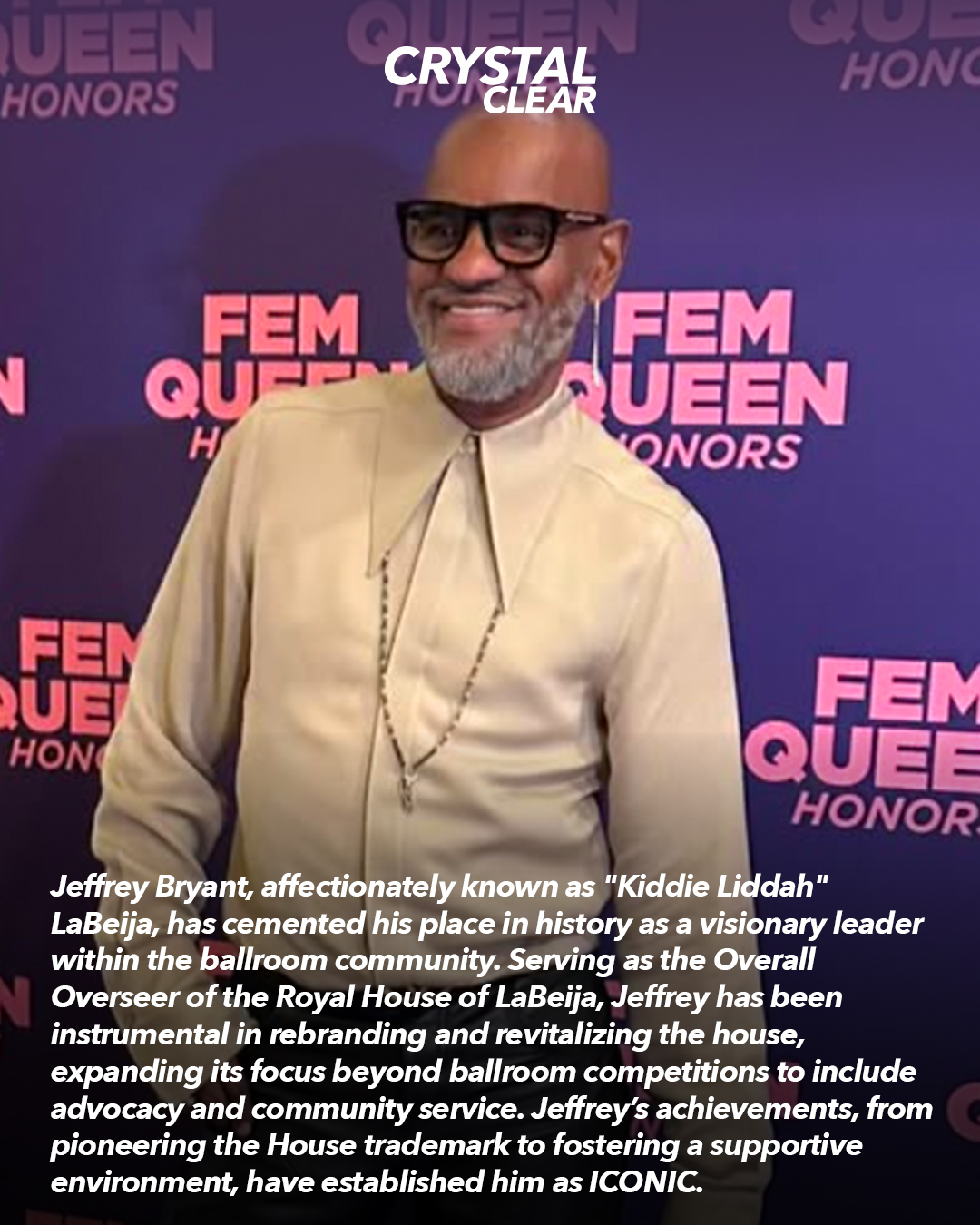
Member Spotlight: Icon Jeffrey "Kiddie Liddah" LaBeija
Jeffrey Bryant—affectionately known as Kiddie Liddah LaBeija—is not just a leader; he is a cultural architect who dares to shape history while others watch it unfold. As the Overall Overseer of the Royal House of LaBeija, Jeffrey has led with intention, transforming the house into not only a competitive force, but a vessel for advocacy, artistry, and healing.
But his story doesn’t begin with LaBeija—it stretches back to the roots of the West Coast ballroom scene, where Jeffrey helped pioneer one of the first houses in the region: the House of Rodeo. At a time when ballroom was still largely East Coast-centered, Jeffrey was helping establish new soil, new stages, and new possibilities for the culture to grow. That foundation would shape the expansive leadership style he’s now known for.
That spirit of expansion followed him into his work with LaBeija. Over the years, Jeffrey played a vital role in extending the house’s reach across regions and time zones—laying groundwork that helped position LaBeija as a global cultural presence. His vision was clear: the legacy of Crystal LaBeija deserved to move freely across borders, generations, and mediums—not just to survive, but to thrive.
Together with his husband, Father Marcus LaBeija, Jeffrey undertook a monumental act of preservation: securing the federal trademark for the Royal House of LaBeija. In doing so, they became the first to protect a ballroom house at that level—ensuring its name, its legacy, and its labor would no longer be disposable. This wasn’t just legal work. It was cultural reclamation.
That bold step—and the clarity it demanded—didn’t come without resistance. But it didn’t dim his light. If anything, it forced the world to see it.
Because let’s be honest—what Jeffrey represents challenges the expected formula. In ballroom, we’re taught: Turn it on the floor, or you don’t matter. But what happens when someone turns it in the boardroom? In the museum? In the courtroom? What happens when someone protects the legacy instead of just living in it?
Jeffrey didn’t build his name through the usual path of trophies and ten battles in a row. His impact came from doing the work that few ever see but everyone benefits from. He didn’t just show up to be applauded—he showed up to build something that lasts. And in doing so, he’s expanded the definition of what it means to be legendary.
Nothing embodies that vision more than the Crystal LaBeija Monument Initiative.
Led by Jeffrey and Marcus, the community witnessed history in April 2025 when a bust of Crystal LaBeija—ballroom’s founding mother—was unveiled at the Museum of the City of New York. It marked the first time a ballroom figure has been formally memorialized in a museum. But more than that, it was us recognizing ourselves. No waiting. No begging. Just building. And that, too, is iconic.
In August 2022, Jeffrey and Marcus made history again with the first wedding inside the Royal House of LaBeija—a union born from love, sustained by mission. Their relationship, both personal and professional, continues to expand what is possible in a culture too often reduced to competition alone.
Jeffrey’s work speaks in volumes: through the trademark, through the monument, through the voices he uplifts and the silence he breaks. His leadership doesn’t need applause to be real. The impact is already written—in policy, in protection, in people.
In a moment when it would be easier to shrink, Jeffrey stands. And so do we.
The Royal House of LaBeija shines because its leadership refuses to flicker.
Let that be the legacy.
Let that be the light.
Because that’s what we do.
We don’t just take up space—we create it.
Not just on the floor, but beyond it.
That is the movement.
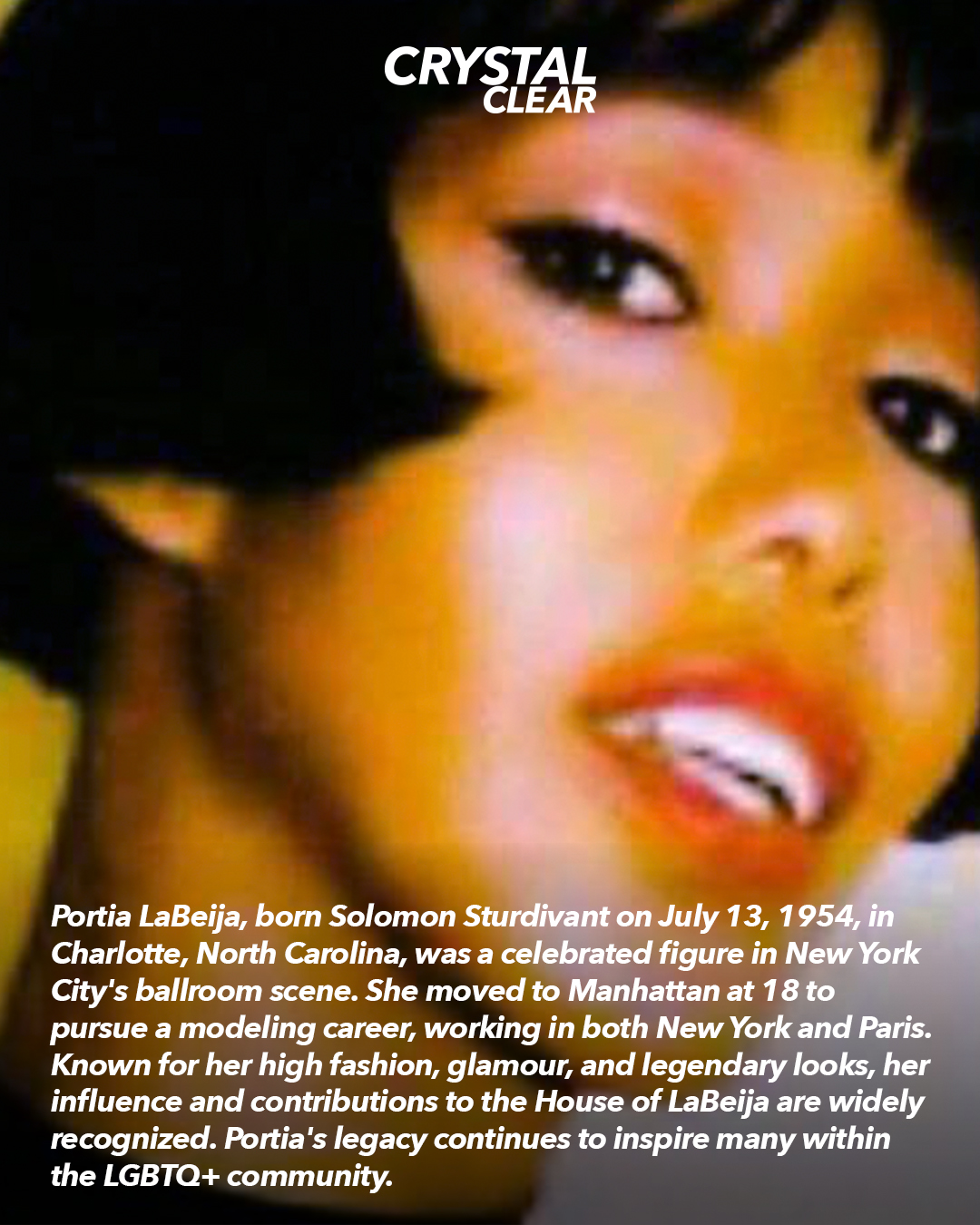
History Spotlight : Tiny LaBeija
Portia LaBeija, born Solomon Sturdivant on July 13, 1954, in Charlotte, North Carolina, was a celebrated figure in New York City's ballroom scene. After graduating from Garinger High School in 1974, she moved to Manhattan at 18 to pursue a modeling career, working in both New York and Paris.
As a prominent member of the House of LaBeija, Portia was instrumental in shaping ballroom culture. While specific details about her tenure and titles within the house are not well-documented, her influence and contributions are widely recognized. Portia's legacy continues to inspire many within the LGBTQ+community. She passed away on February 20, 2014.
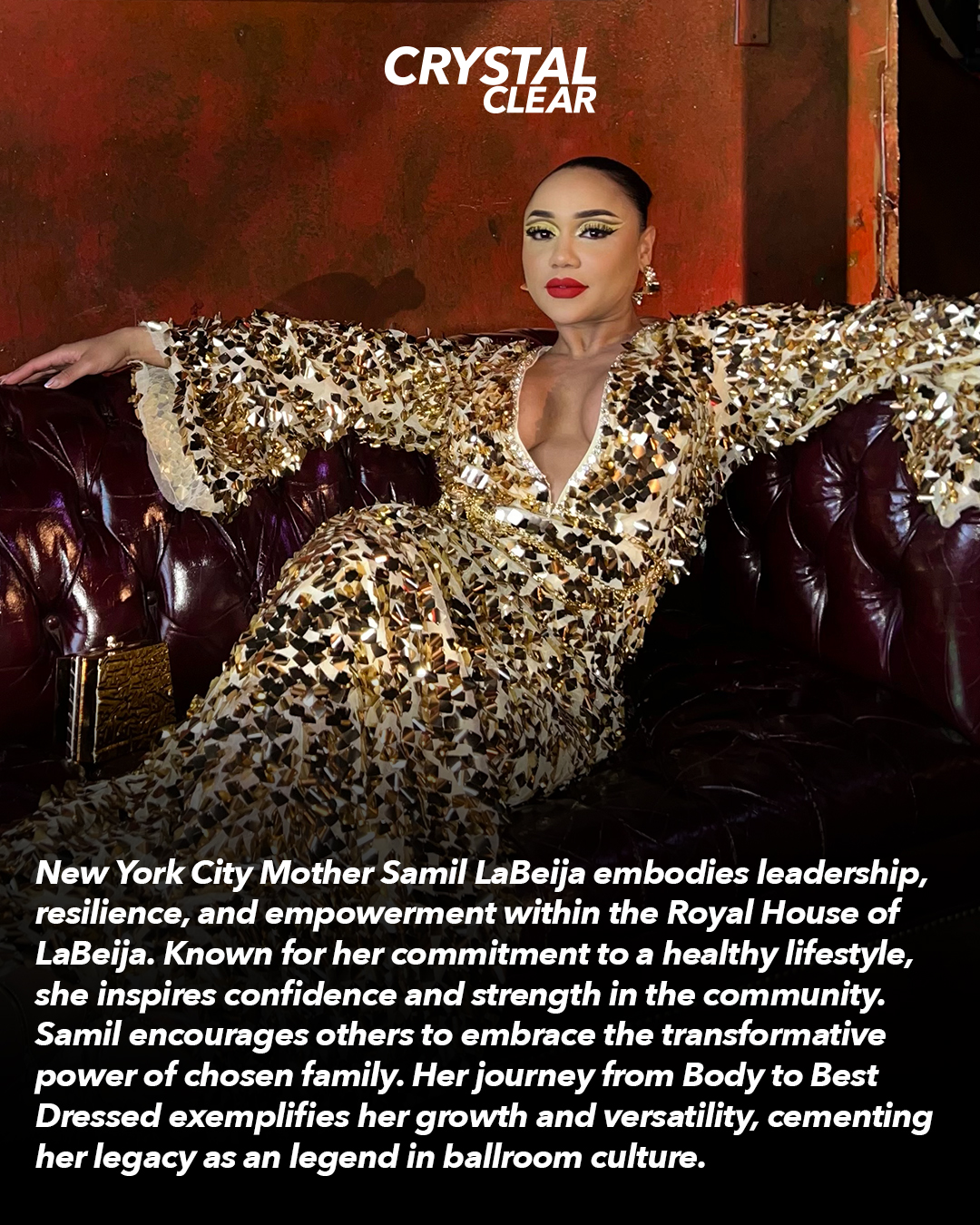
Member Spotlight on Mother Samil LaBeija
New York City Mother Samil LaBeija (she/her) embodies leadership, resilience, and empowerment within the Royal House of LaBeija. Known for her commitment to a healthy lifestyle, she inspires confidence and strength in the community, serving as a powerful example of physical fitness and wellness for other females. As a celebrated figure in the ballroom scene, Samil has excelled in the Body category earning multiple "Of the Year" awards for her striking physique. Recently, she has graduated to the prestigious Best Dressed category, continuing to shine as a paragon of elegance and excellence.
In December 2019, Samil was appointed the first New York City Chapter Mother of the Royal House of LaBeija by Pioneer Junior LaBeija. Since then, she has been anunwavering leader, mentoring house members in personal development, résumé building, and addiction counseling. Her dedication reflects the house’s core values, ensuring its legacy continues to thrive.
In 2021, Samil participated in Taco Bell's “Drive-Thru Dialogues” campaign, celebrating chosen families in the LGBTQIA+ community. Alongside Aja LaBeija, she highlighted the importance of love and support beyond biological ties,
amplifying ballroom culture’s message of unity to a broader audience. The following year, she was featured in the short documentary The House of LaBeija, which premiered at the Tribeca Film Festival in 2022. The film paid homage to the house through letters from its members, celebrating its profound influence on ballroom culture and LGBTQIA+ history. Samil’s feature underscores her pivotal role in preserving and celebrating the house’s rich legacy.
In 2023, Samil traveled to Brussels to represent the Harlem Fantasy Exhibit at Bozar, a renowned cultural center in Belgium. Speaking on behalf of the Royal House of LaBeija, she shared insights about ballroom’s historical and cultural significance, further establishing herself as a global cultural ambassador.
In 2024, she was featured in Alexis Bittar’s celebrated “Bittarverse” campaign, where she showcased the artistry of ballroom on a global platform. Thiscollaboration merged luxury fashion with ballroom heritage, honoring the intersection of creativity, identity, and empowerment.
Through her leadership, advocacy, and cultural contributions, NYC Mother Samil LaBeija continues to elevate the Royal House of LaBeija while inspiring others to embrace wellness, empowerment, and the transformative power of chosen family. Her journey from Body to Best Dressed exemplifies her growth and versatility, cementing her legacy as an legend in ballroom culture.

Member Spotlight on Father Marcus LaBeija
Father Marcus LaBeija, also known as Marcus Henderson, has become a pillar of leadership and innovation within the Royal House of LaBeija. Raised in Rochester, New York, Marcus was instilled with a strong commitment to education and service, which he carried through his studies at Tuskegee University and Long Island University, earning dual master’s degrees in Media Arts/Production and Film Directing. Inspired by the documentary Paris Is Burning during his college years, he was drawn to the vibrant ballroom culture and eventually joined the Royal
House of LaBeija in 2019.
Marcus’s entry into the ballroom scene was as bold as it was impactful. When he debuted in the highly competitive category of Executive Realness, he did so while also stepping into his role as Father of the house. It was a unique moment that underscored his leadership and presence, as he captured the grand prize in his first-ever competition. Known for his poise and versatility, Marcus also competes in Best Dressed, demonstrating his ability to excel in two distinct categories—a feat that reflects his commitment to both authenticity and style.
Marcus’s leadership journey began with his deep commitment to preserving the legacy of the Royal House of LaBeija. Alongside his husband, Jeffrey "Kiddie Liddah" LaBeija, he achieved a groundbreaking milestone by securing the official trademark for the house. This historic feat made LaBeija the first ballroom house to attain such recognition, setting a precedent for the community and ensuring its cultural and intellectual legacy would endure.
In his early leadership years, Marcus partnered with BET to produce the documentary short Ballroom: A Safe Space, part of the network’s Queer As F**k! series. This powerful work highlighted the ballroom community as a haven of creativity and resilience, showcasing the importance of safe spaces for LGBTQ+ individuals of color.
Building on this success, Marcus collaborated with visionary director Fredgy Noel in 2022 to create the documentary short film The House of LaBeija. The film debuted at the Tribeca Film Festival, marking the first time a work from ballroom premiered at such a globally recognized festival. The project celebrated the rich history and cultural impact of the Royal House of LaBeija, cementing ballroom’s place in the broader cultural and cinematic landscape.
In August 2022, Marcus and Jeffrey celebrated their wedding—the first union within the Royal House of LaBeija. This milestone symbolized their shared commitment to the values of love, family, and legacy that define the house and ballroom culture.
The following year, Marcus honored the memory of his friend and former housemember, O’Shae Sibley, with the BET special O’Shae Sibley: He Was Victimized, But He Wasn’t A Victim. This heartfelt tribute ensured that O’Shae’s story, one of resilience and love, reached far beyond the ballroom, reminding the world of the challenges faced by LGBTQ+ individuals and the community’s enduring strength.
Later in 2023, Marcus spearheaded the Sephora campaign We Belong to Something Beautiful. This groundbreaking initiative celebrated individuality and inclusivity while bringing ballroom culture to mainstream audiences, demonstrating Marcus’s ability to bridge tradition with modern cultural platforms.
In 2024, Marcus continued his work with BET, producing the segment Vogue as an Act of Resistance. This piece explored the revolutionary roots of voguing, showcasing how it serves as both an art form and a tool for activism within the LGBTQ+ community.
That same year, Marcus was featured in the award-winning Bittarverse campaign by renowned jewelry designer Alexis Bittar. This groundbreaking campaign celebrated individuality and artistry, aligning seamlessly with Marcus’s own mission to elevate ballroom culture and its icons to mainstream platforms. His participation in this high-profile campaign brought further visibility to the Royal House of LaBeija, showcasing its influence in the fashion and cultural spheres.
Currently, Marcus is spearheading Crystal Clear: The Crystal LaBeija Monument Initiative, an ambitious project to memorialize Crystal LaBeija’s monumental contributions to starting the ballroom scene. This initiative seeks to immortalize Crystal in statue form and within the museum industry, cementing her place not just in ballroom history but in Black and queer history. Marcus envisions this project as a way to elevate Crystal LaBeija and the Royal House of LaBeija beyond a cultural phenomenon, into an enduring legacy of resilience, creativity, and representation.
Through visionary leadership, runway excellence, and unwavering dedication, Father Marcus LaBeija continues to build bridges between the ballroom scene and mainstream platforms, ensuring its voices are heard and its artistry celebrated. His tireless efforts honor the past while inspiring a future where ballroom culture thrives as a force for creativity, empowerment, and resistance.